Soft, gooey dough stuffed with a tasty filling, Sichuan leaf-wrapped sticky rice cakes are a delightful, easy-to-make snack. This recipe shows you how to make them in two colours with two different fillings.
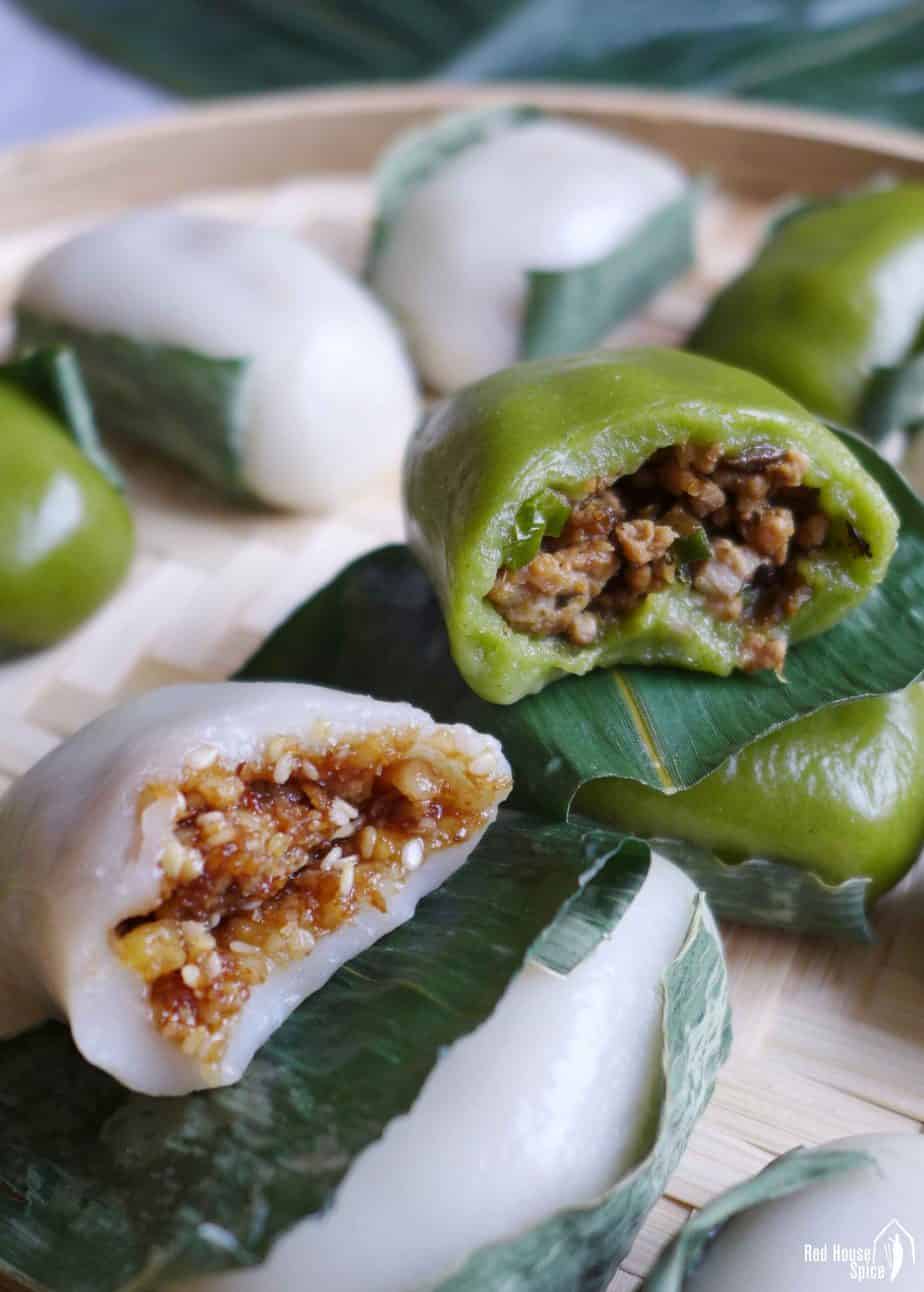
What are leaf-wrapped sticky rice cakes
Sichuan leaf-wrapped sticky rice cake, known as Ye’er Ba/叶儿粑 in Chinese, is a classic street food originating from rural areas of Sichuan province, China. They are steamed parcels consisting of gooey sticky rice dough and tasty savoury or sweet filling. Each cake is individually wrapped with a piece of leave to prevent sticking and to add extra aroma.
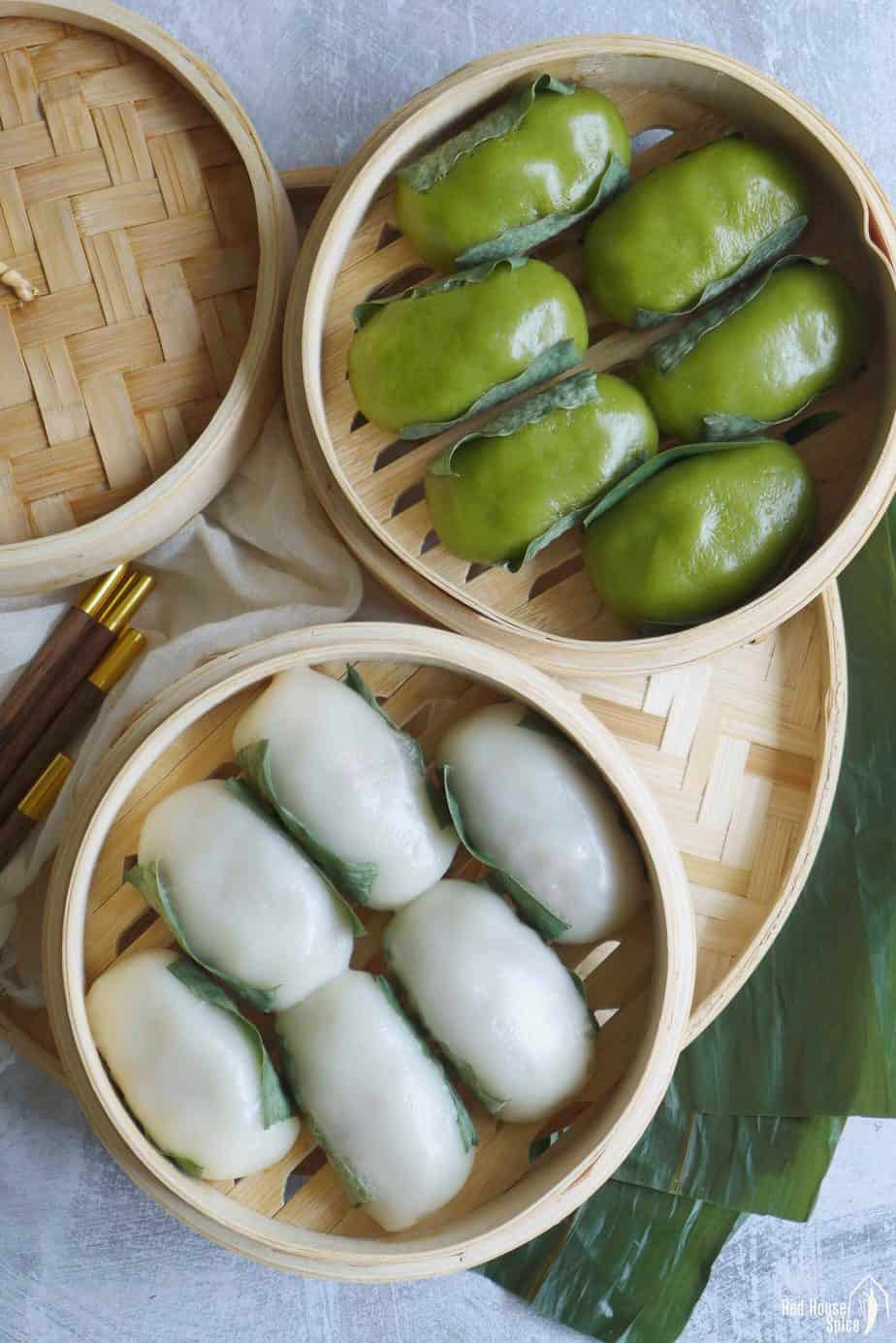
Like many Chinese delicacies made of glutinous rice (Tang Yuan, Zongzi, etc.), these leaf-wrapped sticky rice cakes can be stuffed with both savoury and sweet fillings. Also, you have the choice to use a white dough or add a natural ingredient to make it green. I use spinach-dyed green dough for the pork filling and white dough for the sweet walnut filling.
The savoury version with pork & Ya Cai
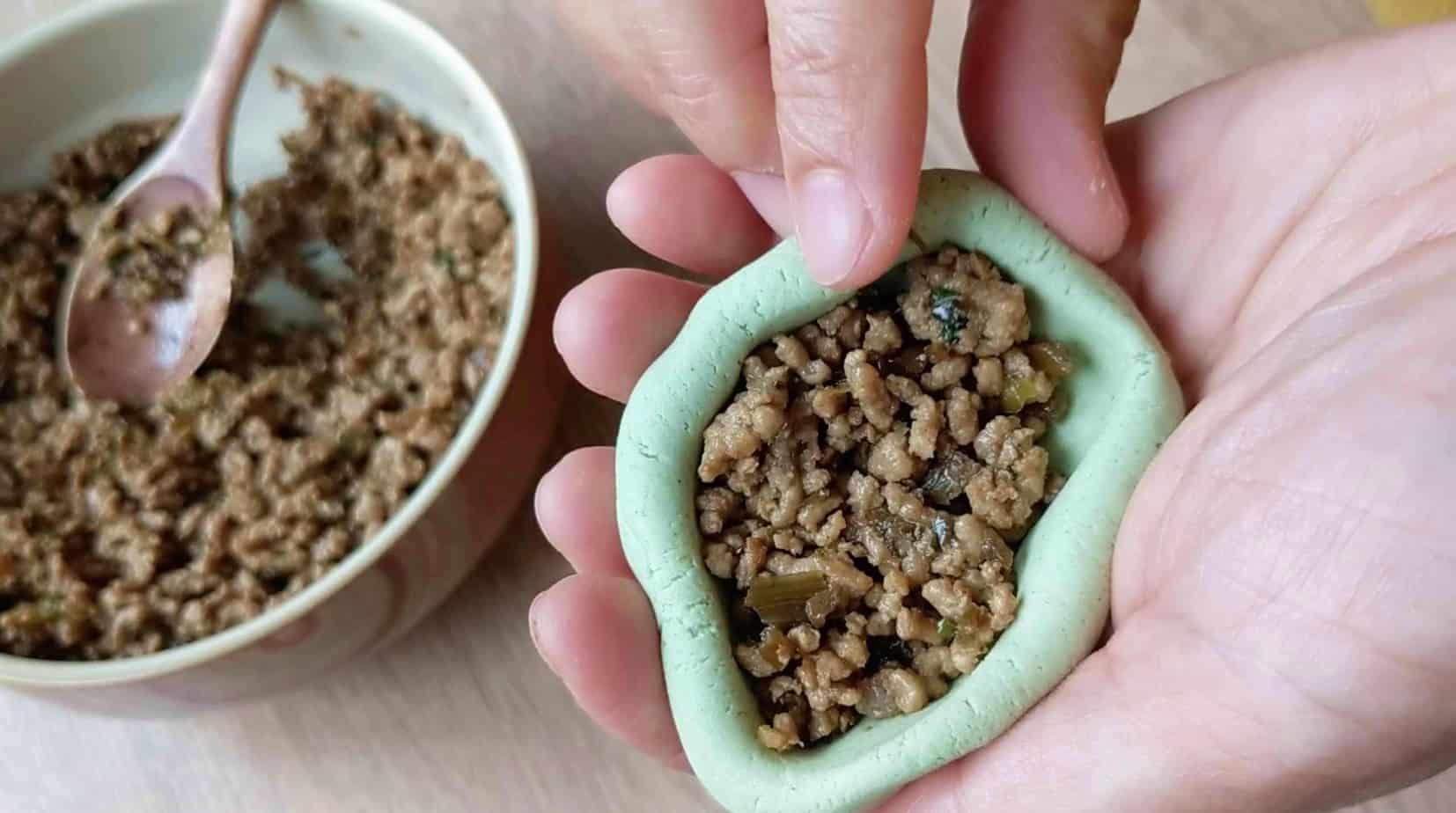
Consisting of minced pork, preserved mustard greens and Sichuan pepper, the savoury filling for leaf-wrapped sticky rice cakes has the distinctive taste of Sichuan food. Unlike Chinese savoury dumplings/buns which are usually stuffed with raw ingredients when assembling, the filling for these cakes is stir-fried beforehand. Here are a few tips to make it tasty:
- Choose fatty pork mince if you can. Buy a ready-ground version or mince it by yourself (this way you can decide your own proportion of lean & fat).
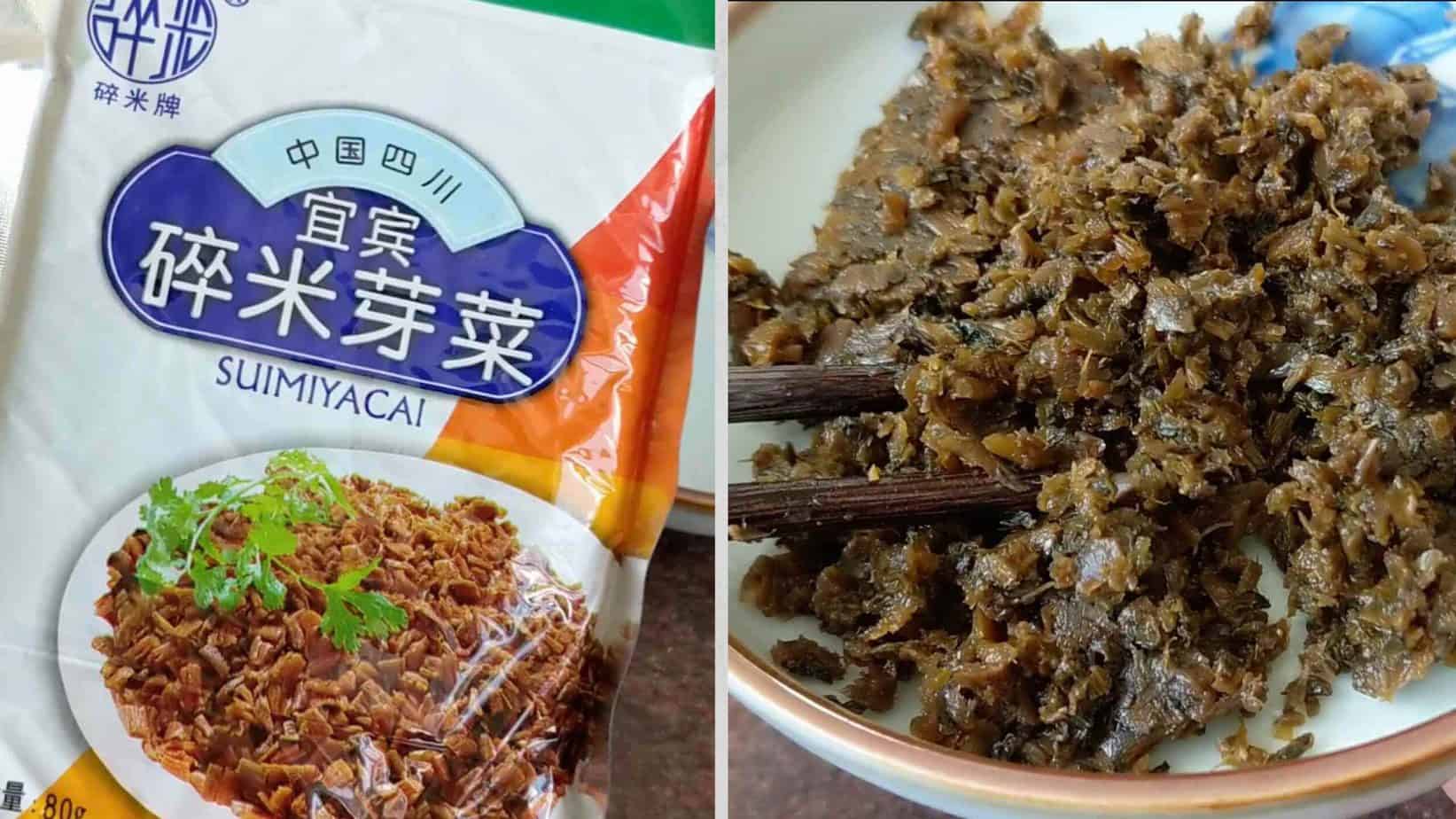
- Ya Cai (芽菜, preserved mustard greens) is essential if you’re looking for an authentic taste. It can be found in plastic packages labelled as Sui Mi Ya Cai/碎米芽菜(see image above), meaning finely chopped Ya Cai, which can be used directly. However, if you find it hard to source, try other types of preserved/fermented vegetables, such as Zha Cai (榨菜, preserved mustard stem), kimchi, etc. It wouldn’t be considered “authentic”, but it will still taste great!
- Use freshly ground Sichuan pepper if possible. I have a post explaining in detail how to grind Sichuan peppercorn properly.
- Lard is used in the traditional recipe for frying. You may also use regular cooking oil as I do.
The sweet version with walnuts & sesame seeds
Many sweet fillings can go into these sticky rice cakes. My favourite ones are red bean paste, black sesame paste and toasted walnut filling that I’ve sharing today. Simply mix the following ingredients and chill for a while before assembling.
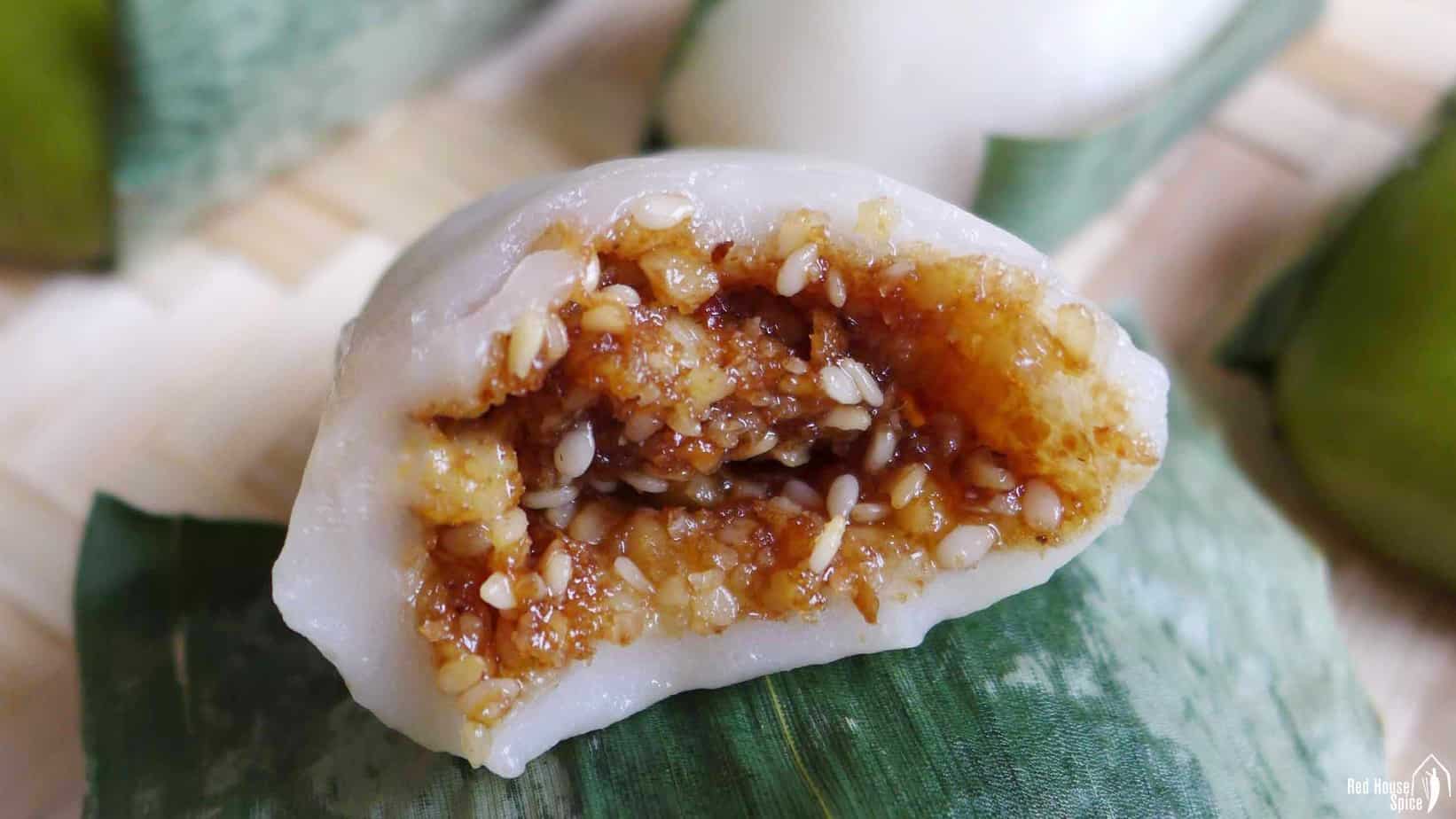
- Walnuts. Toast them in a frying pan over low heat until lightly brown. Leave to cool then put into a sealable plastic bag. Use a rolling pin to crush into small pieces.
- Sesame seeds. Use the same method to toast and crush them.
- Dark brown sugar. Containing a high percentage of molasses, dark brown sugar has a sophisticated, caramel-like taste which pairs very well with nuts.
- Softened butter or lard. Once again, lard is used in the authentic version but butter works perfectly too.
How to make the dough
Apart from the tasty filling, what makes these sticky rice cakes attractive is its soft, springy wrapper. The perfectly made dough produces a well-balanced gooey texture. As the locals say, it should be “San Bu Zhan/三不沾”: meaning it doesn’t stick to the plate, chopsticks or your teeth. Here is what you need:
- Glutinous rice flour (糯米粉). It’s the key ingredient which gives the cooked dough a spring, gooey texture. It’s commonly used in many sweet Chinese delicacies, such as Tang Yuan, Sesame Balls, Snow Skin Mooncakes, etc.
- Rice flour (粘米粉). Made of regular rice, it’s to help the dough to stay in shape after steaming and to avoid it being overly sticky (it’s used in classic Chinese New Year Cake). The ideal ratio (by weight) is 4 parts of glutinous rice flour mixed with 1 part of rice flour.
- Cooking oil or softened lard. Fat is used to give the dough a shine and it also helps to reduce the stickiness. The traditional recipe calls for lard which provides an extra rich flavour. Regular cooking oil works very well too. Please feel free to make your own choice.
- Water at room temperature.
- Spinach powder or matcha powder. They are for colouring the dough thus entirely optional. If using, you would need to add a further 5% of water to the dough.
Easy kneading
It’s super easy to make the dough! Unlike wheat flour-based dough for dumplings, there is no lengthy kneading required as these two types of flour do not contain gluten. Simply combine all the ingredients and knead for no more than a couple of minutes.
Also, you can easily adjust the dough consistency even after it has been formed. To make wrapping an easy job, the dough should be quite soft but doesn’t stick to your hands. If it appears to be dry, knead in a few drops of water. If too wet, sprinkle a little glutinous rice flour.
No resting
This type of dough doesn’t need resting. In fact, you should use it up as soon as it’s made as it dries out easily. That’s why in my recipe I suggest you make the filling first. During the assembly process, remember to cover the unused dough at all time. If for whatever reason the dough has been left for some time and becomes drier, knead in a little water to soften.
Wrapper choices
Another distinctive feature of this dish is that each cake is held by a piece of leaf. Not only does it prevent sticking, it also adds natural, subtle aroma to the cake. Tangerine leaves are often used as wrappers in Sichuan.
However, other types of leaves also work well as substitutes: Bamboo leaves (commonly used for wrapping Zongzi), banana leaves or corn husks. If the leaves of your choice come in dried form, soak them overnight to soften.
If none of the leaves mentioned above is available, please feel free to use regular parchment paper instead. Believe me! They will still taste wonderful!
Steam and serve
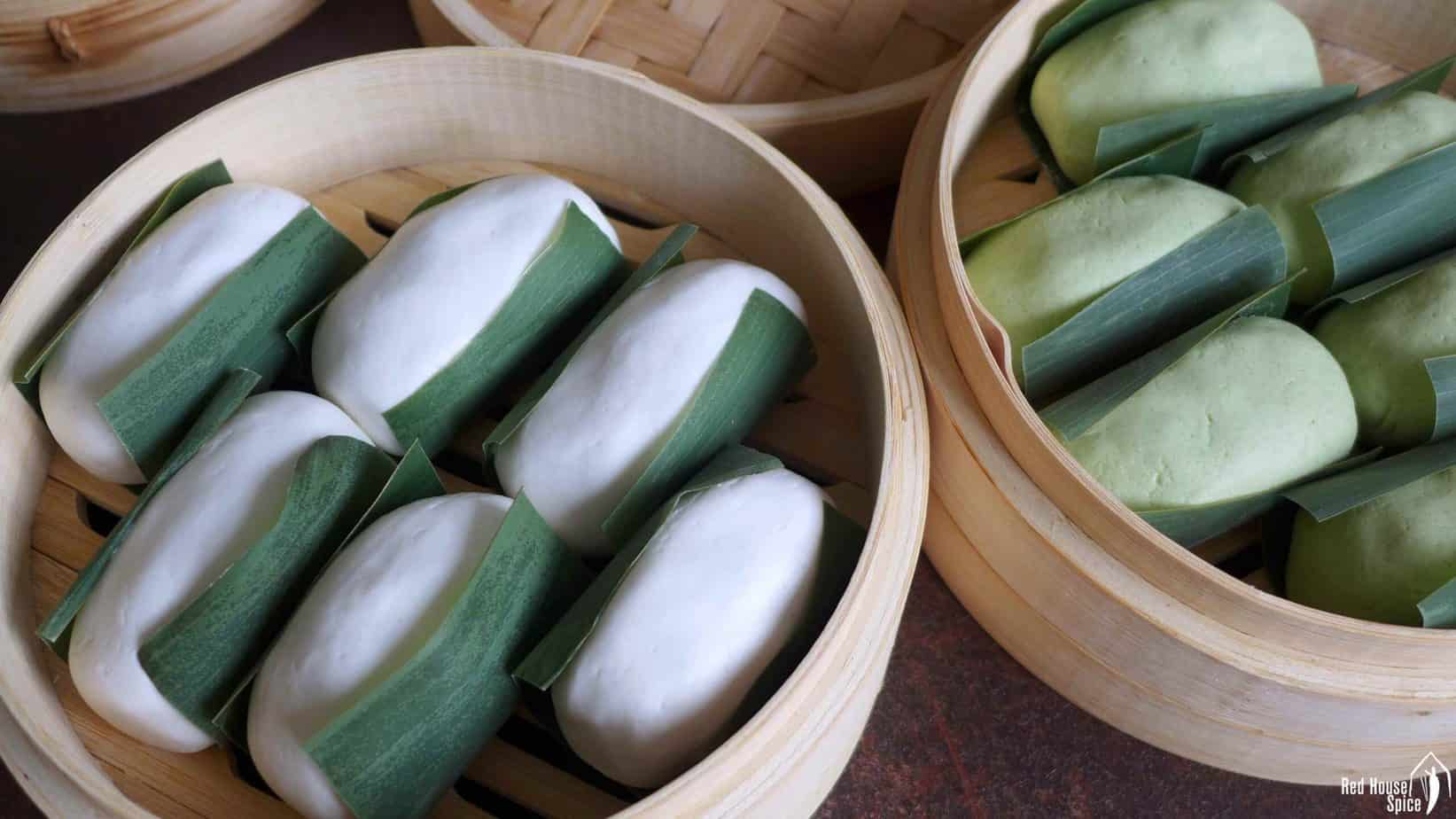
The final step, steaming, is pretty straight forward: Place the assembled sticky rice cakes into steamer baskets. Bring water to a full boil in a wok/pot then put the basket on top. Steam over medium heat for 8 mins. Done!
Serve straight away as they taste the best when warm. Be careful not to burn your tongue as the air inside can be very hot. Bite a small hole to release the heat first then carry on eating.
If you wish to make them in advance, freeze uncooked cakes right after they are assembled. Firstly place them in a single layer on a tray/plate lined with parchment paper. Once completely frozen, transfer them to an airtight container/bag. When ready to cook, wrap each one in a piece of leaf, then steam for 12 mins without defrosting.
Other Sichuan Recipes
Passionate about Sichuan food? Check out other classic dishes on my blog:
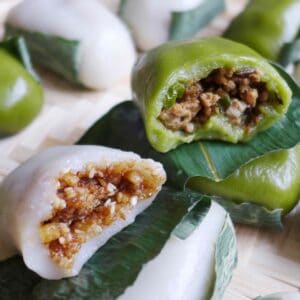
Sichuan leaf-wrapped sticky rice cake (叶儿粑)
Ingredients
For the savoury filling
- 1 tablespoon cooking oil or lard
- 200 g minced pork - 7oz
- 1 teaspoon minced ginger
- 3 tablespoon Ya Cai (preserved mustard greens) - see note 1
- ½ teaspoon Shaoxing rice wine
- ½ teaspoon light soy sauce
- ½ teaspoon dark soy sauce
- 1 pinch sugar
- ½ teaspoon ground Sichuan pepper
- 1 stalk scallions, finely chopped
For the sweet filling
- 120 g walnuts, toasted & crushed - see note 2
- 3 tablespoon sesame seeds, toasted & crushed
- 4 tablespoon dark brown sugar - or to taste
- 3 tablespoon softened butter or lard
For the dough
- 200 g glutinous rice flour - about 1.5 cup
- 50 g rice flour - about ⅓ cup
- 2 tablespoon cooking oil or softened lard
- 210 ml water - about 14 tbsp, see note 3
- 3 teaspoon spinach powder or matcha powder - optional, see note 4
You also need
- Bamboo leaves, cut into 12 rectangle pieces - see note 5 for substitutes
Instructions
Fry the savoury filling
- Pour oil into a hot wok. Add pork and ginger. Fry until the meat turns pale.
- Stir in Ya Cai. Then add Shaoxing rice wine, light & dark soy sauce, sugar & ground Sichuan pepper.
- Cook for 1 minute or so. Stir in scallions. Mix then dish out. Leave to cool.
Make the sweet filling
- Toast raw walnuts in a frying pan (without any oil) over low heat. When lightly browned, transfer to a plate to cool. Then put into a sealable plastic bag. Use a rolling pin to crush into small pieces.
- Follow the same instruction to toast and crush raw sesame seeds (you may use ready toasted ones and simply crush them a little).
- Mix them with brown sugar and butter/lard. Store in the fridge before assembly.
Prepare the dough
- Add all the ingredients for the dough into a bowl. Mix with a pair of chopsticks/spatula until no liquid can be seen.
- Knead by hand into a soft dough (but not sticky).
- If you are using spinach or matcha powder to make a green dough, add a little more water (about 2 tsp).
Assemble (please refer to the video below)
- Flatten a piece of dough and make it into a bowl shape.
- Place a spoonful of the savoury or sweet filling in the middle.
- Pinch with fingers to seal completely. Then gently roll it into a cylinder.
- Place it onto the shiny side of a leaf.
Cook
- Place the assembled cakes into steamer baskets. Bring water to a full boil in a wok/pot. Put the baskets on top.
- Steam over medium heat for 8 mins. Serve warm.
Make in advance
- You may freeze uncooked cakes right after they are assembled. Firstly place them in a single layer on a tray/plate lined with parchment paper. Once completely frozen, transfer to an airtight container/bag.
- Steam for 12 mins without defrosting.
Video
NOTES
NUTRITION DISCLOSURE: Nutritional information on this website is provided as a courtesy to readers. It should be considered estimates. Please use your own brand nutritional values or your preferred nutrition calculator to double check against our estimates.


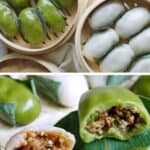
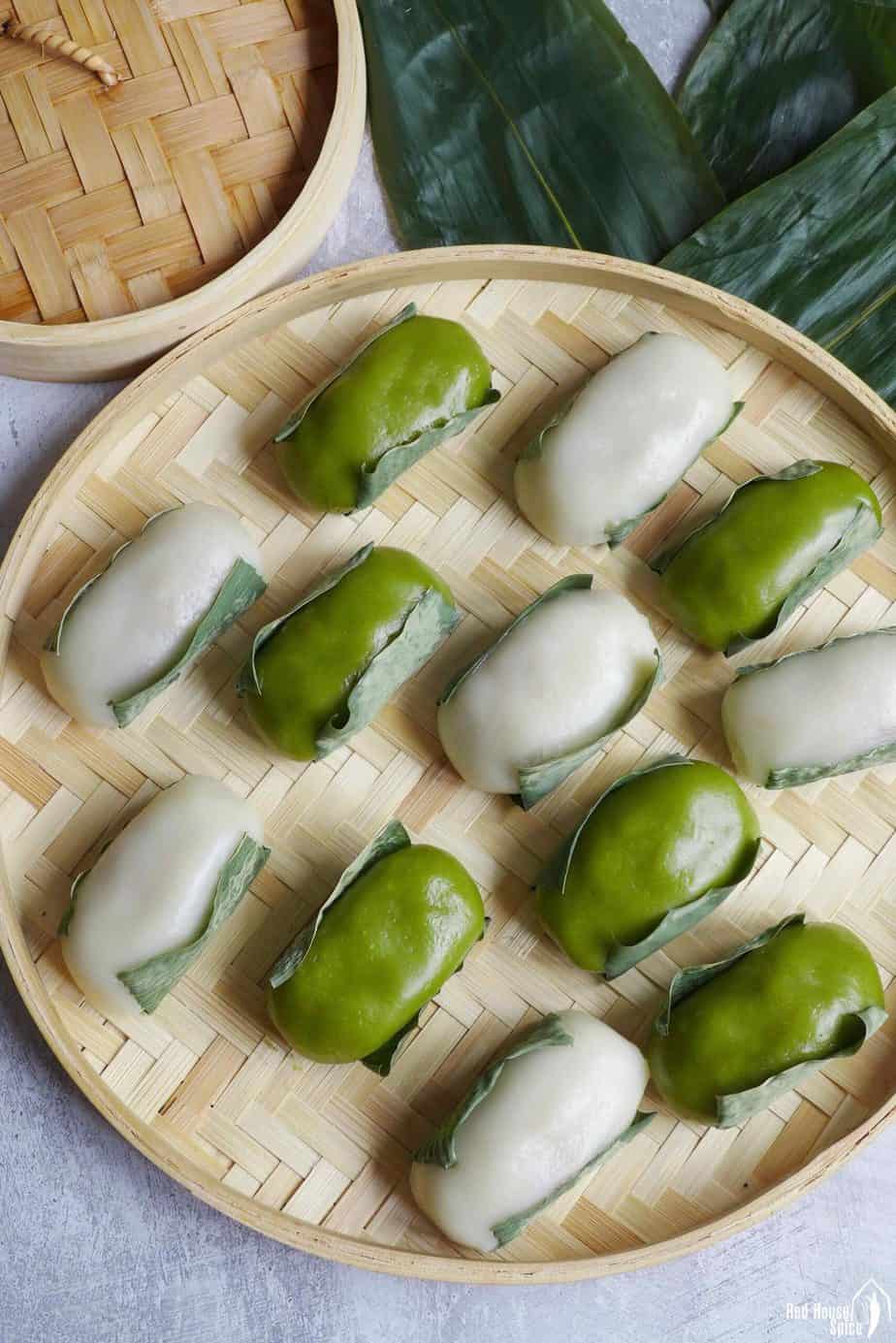
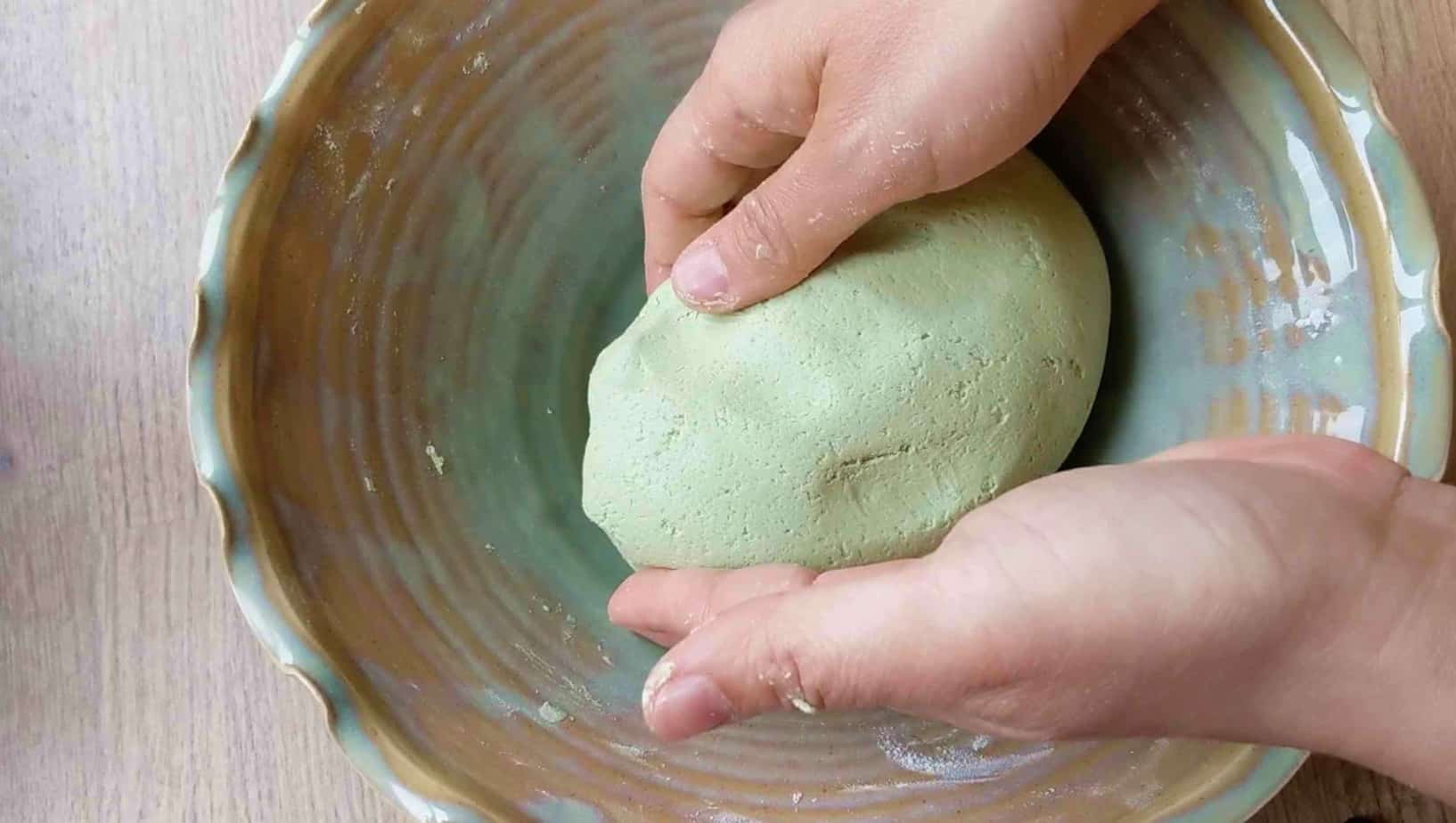
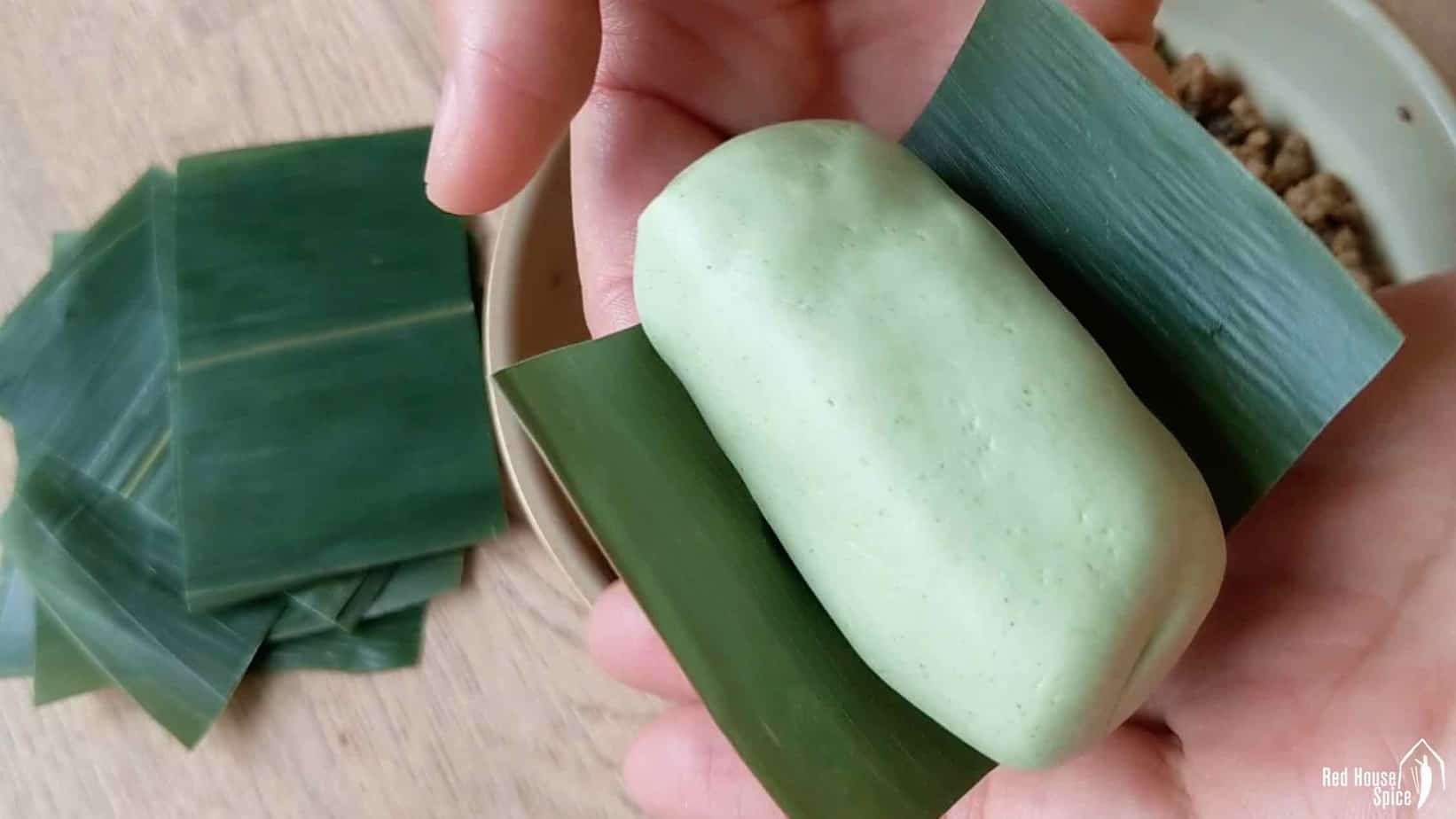
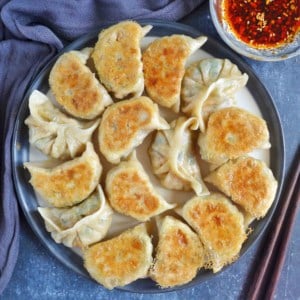
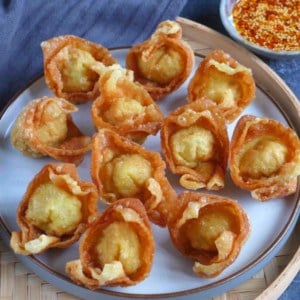
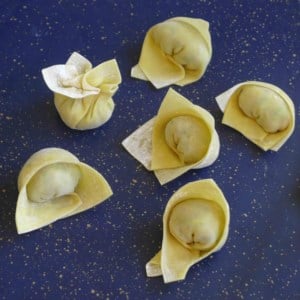
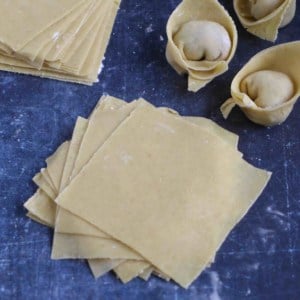
Would lotus leaf work for this recipe?
Yes, you can use lotus leaves too. Happy steaming!
Every single recipe you post looks so delicious I want to make it right away!
Thanks Kalia! Let me know how you like it!